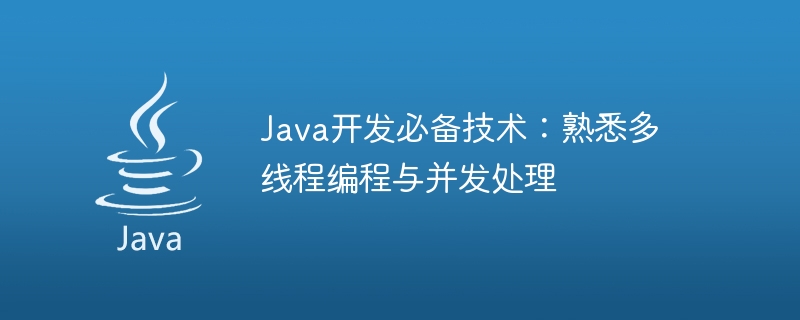Home >Java >javaTutorial >Essential Java development skills: Proficient in multi-threaded programming and concurrent processing
Essential Java development skills: Proficient in multi-threaded programming and concurrent processing
- WBOYWBOYWBOYWBOYWBOYWBOYWBOYWBOYWBOYWBOYWBOYWBOYWBOriginal
- 2024-01-11 16:15:061038browse

As an object-oriented programming language, Java is one of the most popular and widely used languages in the field of software development today. In Java development, familiarity with multi-threaded programming and concurrent processing is an essential technology. This article will introduce the basic concepts of multithreading, the importance of concurrent processing, and provide some specific code examples to help readers better understand and apply this technology.
1. The basic concept of multi-threading
Multi-threading refers to running multiple threads at the same time in a program. Each thread can perform different tasks, thereby improving the running efficiency of the program. Compared with single thread, multi-thread can make better use of CPU resources, enable the program to handle multiple tasks at the same time, and improve the response speed and throughput of the system.
In Java, multi-threaded programming is implemented through the Thread class and Runnable interface provided by Java. The Thread class represents a thread, and the Runnable interface can implement multiple threads. By inheriting the Thread class or implementing the Runnable interface and implementing the run() method, you can define the tasks to be performed by the thread.
2. The importance of concurrent processing
In modern computer systems, multi-core processors have become the mainstream configuration. In order to fully utilize the performance of multi-core processors, programs need to utilize concurrent processing technology to achieve the ability of multi-threaded parallel execution.
Concurrent processing can bring many benefits, such as improving the response speed of the program, improving the throughput of the system, and making better use of system resources. In some systems that need to handle a large number of concurrent requests, such as network servers, database systems, etc., the reasonable use of multi-threaded concurrent processing technology can significantly improve the performance and throughput of the system.
3. Specific code examples of multi-threaded programming and concurrent processing
In order to help readers better understand and apply multi-threaded programming and concurrent processing technology, we provide some specific code examples.
- Example of creating a thread
You can create a thread by inheriting the Thread class or implementing the Runnable interface. The following is an example of creating a thread by implementing the Runnable interface:
public class MyRunnable implements Runnable {
public void run() {
// 线程要执行的任务
}
}
public class Main {
public static void main(String[] args) {
Runnable myRunnable = new MyRunnable();
Thread thread = new Thread(myRunnable);
thread.start();
}
}- Example of thread lock
In concurrent processing, multiple threads may access and modify shared data at the same time. In order to ensure the consistency and correctness of data, thread locks need to be used to control access to shared data.
The following is an example of using the synchronized keyword to implement a thread lock:
public class Counter {
private int count = 0;
public synchronized void increment() {
count++;
}
public int getCount() {
return count;
}
}- Example of multi-thread synchronization and waiting
In the process of multi-thread concurrent processing , in order to ensure that each thread can execute in a certain order, you can use the wait() and notify() methods to synchronize and wait for threads.
The following is an example of using the wait() and notify() methods to implement thread synchronization and waiting:
public class ProducerConsumer {
private List<Integer> buffer = new ArrayList<>();
private final int SIZE = 5;
public void produce() throws InterruptedException {
synchronized (this) {
while (buffer.size() == SIZE) {
wait();
}
int value = /* 生成一个新的数据 */;
buffer.add(value);
notify();
}
}
public void consume() throws InterruptedException {
synchronized (this) {
while (buffer.isEmpty()) {
wait();
}
int value = buffer.remove(0);
notify();
}
}
}The above example is only the tip of the iceberg in multi-threaded programming. In actual development, multi-threading technology is widely used, and the knowledge points involved are also relatively complex. It is necessary to have an in-depth understanding of the basic principles and common problems of multi-threading, and to flexibly use multi-threading related technologies to solve practical problems.
Conclusion
This article introduces the necessary technologies in Java development-familiarity with multi-threaded programming and concurrency processing, and provides some specific code examples. Multi-threaded programming and concurrent processing are important parts of Java development. Mastering this technology can improve the performance and throughput of the program, and bring better development experience and user experience to developers. I hope this article can help readers better understand and use multi-threaded programming and concurrent processing technology.
The above is the detailed content of Essential Java development skills: Proficient in multi-threaded programming and concurrent processing. For more information, please follow other related articles on the PHP Chinese website!
Related articles
See more- What are the Java development tools? Recommended 16 Java development tools
- What is java development environment
- How does PHP implement multi-threading and concurrent processing?
- PHP Efficient Development Guide: Master the Concurrency Processing Skills of Alibaba Cloud OCR
- PHP high concurrency processing methods and practices

